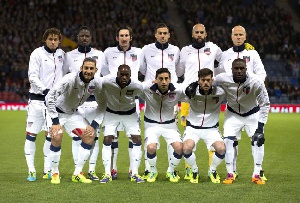The Americans couldn’t have been dealt a more difficult task. They will open the World Cup against Ghana, a team that’s knocked them out of the past two World Cups and then face Portugal and Germany, the powers heavily favored to advance.
As if the Group of Death isn’t bad enough, the Americans will also have to deal with the most challenging travel schedule in the tournament. From base camp in Sao Paulo in the south, the Americans will traverse the fifth-largest country in the world and play at three northern sites — Natal, Manaus and Recife. In all, the U.S. team will travel almost 9,000 miles in its opening games. The U.S. team doesn’t travel lightly.
When the team arrived Monday, there were 220 pieces of luggage, including trunks, duffel bags, technical equipment, weighing 11,000 pounds, plus the players and staff.
Before the players arrived, U.S. Soccer had already shipped 94 boxes and bags of food, trunks, duffel bags and technical equipment weighing 7,050 pounds.
Among those supplies: breakfast cereals that are not available in Brazil; flaxmeal and vanilla whey protein; cooking supplies and condiments; almond butter.
The U.S Soccer contingent of 51 includes 23 players, four coaches, five scouts, 11 members of performance staff (strength and fitness coach, four trainers, two doctors, two equipment managers, chef, nutritionist), three U.S. Soccer officials, four administrators (including a security officer and Nike representative) and one press officer.
In Natal, where the USA will play Ghana on June 16, the Americans will have to travel about 1,400 miles. Ghana is based just 270 miles south. Manaus is in the Amazon rainforest and real-feel temperatures could be close to 90 when the USA meets Portugal on June 22.
In Recife on June 26, the USA plays Germany in the early afternoon heat. The average temperature will be around 80, but the humidity will make it feel a bit steamier.
On the bright side, if the USA survives all of this and gets out of Group G, there at least will this reward: With most venues in the south, home base will feel a little more like home.
With 10 MLS players on the roster accustomed to cross country flights and different climates, nearly all downplay the travel. The European-based players have traveled extensively for the U.S. World Cup qualifiers.
“My team (Real Salt Lake) just went from Seattle to Columbus, so we’re used to changing from different altitudes and the humidity,” said midfielder Kyle Beckerman.
“Our players are possibly the most travelled players in the World Cup,” said Tom King, U.S. Soccer’s managing director of administration.
Since the team will fly back to its base in Sao Paulo after games, the players will have to recover on the plane. Fitness director Masa Sakihana said to fight fatigue they need to refuel and hydrate. “I’m not overly concerned,” Sakihana said.
“We have the most travel than anyone else, but we’re playing someone else in Manaus where it’s very warm and we’re going to play someone else in Recife and in Natal,” U.S. Soccer president Sunil Gulati said.
To select and scout the base camp, King took eight trips to Brazil, with the first inspection in July 2011. He reviewed 93 base camps online and inspected 35 in person, narrowing them down to two. Then, there was an inspection of the two options with Jurgen Klinsmann to finalize the decision.
King’s best tip for an American fan headed to the World Cup: “Brazil will host a great World Cup. Bring some patience and a sense of humor and it will be an amazing experience.”
Soccer News of Friday, 13 June 2014
Source: ghanasoccernet.com

















